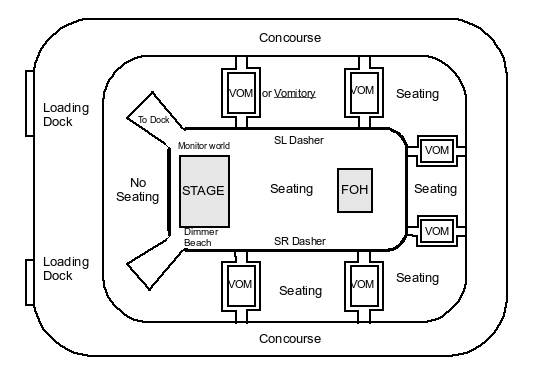THEATRE SPACES
Theatre: a space where a performance takes place, a large machine in the form of a building specialized for presenting performances.Stage types:
Proscenium stage:A proscenium theatre is what we usually think of as a "theatre".
It's primary feature, is the Proscenium, a "picture frame" placed around the front of the playing area of an end stage.
Theframe is the Proscenium; the wings are spaces on either side, extending off-stage. Scenery surrounds the acting area on all sides except side towards audience, who watch the play through frame opening. "Backstage" is any space around the acting area out of sight of the audience.
Thrust theatre:
A Stage surrounded by audience on three sides. The Fourth side serves as the background.
In a typical modern arrangement: the stage is often a square or rectangular playing area, usually raised, surrounded by raked seating.
End Stage:
A Thrust stage extended wall to wall, like a thrust stage with audience on just one side, the front.
"Backstage" is behind the background wall. There is no real wingspace to the sides, although there may be entrances there. An example of a modern end is a music hall, where the background walls surround the playing space on three sides. Like a thrust stage, scenery primarily background.
Arena Theatre:
A central stage surrounded by audience on all sides. The stage area is often raised to improve sightlines.
Flexible theatre:
Sometimes called a "Black Box" theatre, these are often big empty boxes painted black inside. Stage and seating not fixed. Instead, each can be altered to suit the needs of the play or the whim of the director.
Profile Theatres:
Often used in "found space" theatres, i.e. converted from other spaces.
The Audience is often placed on risers to either side of the playing space, with little or no audience on either end of the "stage". Actors are staged in profile to the audience. It is often the most workable option for long, narrow spaces.
Scenically, is most like the arena stage; some background staging possible at ends, which are essentially sides. A non-theatrical form of the profile stage is the basketball arena, if no-one is seated behind the hoops.
Sports Arenas:
Sports arenas often serve as venues for Music Concerts. In form they resemble very large arena stage (more accurately the arena stage resembles a sports arena), but with a retangular floorplan. When used for concert, a temporary stage area is set up as an end stage at one end of the floor, and the rest of the floor and the stands become the audience. Arenas have their own terminology; see below.
Parts of a Proscenium Theatre:
The Proscenium is the defining element of proscenium theatre, basically a big picture frame dividing acting space from audience. All directions defined according to this division of the space by proscenium.Stage directions are given from the viewpoint of an actor center stage facing the audience, Stage Left is the actors left, Stage Right to the actor's right. Downstage is towards the audience, Upstage is towards the back wall of the stage. The Plaster Line (PL) is a line running from the back of one side of the proscenium arch to the other proscenium. The Center Line (CL) runs upstage/downstage half way between prosceniums and perpendicular to the Plaster Line.
Everything downstage of the Plaster line is called Front of House, or FOH. Occasionally it is also called "Ante-proscenium" which means "before the proscenium". Anything the audience can see on the stage is on-stage. Anything on the stage but out of the audience view is off-stage or backstage. Wings are the sides of the stage, and the Fly Loft or Scene House is the space above the stage. The floor is called the Deck.
The part of the stage in from of the Proscenium is the Apron, or sometimes the Thrust. The Audience seating is the Auditorium or the House.
Stage directions: L,C,R,US, DS etc., Plaster and Center Lines:
 Proscenium, FOH, Wings, Apron, Traps and traproom:
Proscenium, FOH, Wings, Apron, Traps and traproom: Scene house, Fly loft, Lock rail, Fly rail, Loading rail, Grid
Scene house, Fly loft, Lock rail, Fly rail, Loading rail, GridHouse, Box boom, Beams, Cove, Booth
 Ancillary areas:
Ancillary areas:*scene and prop shops,
*storage,
*light storage and maintenance,
*costume shop and storage,
*dressing rooms, green room,
*lobby & box office, publicity, administration.
Parts of an Arena:
An Arena is designed for sporting events first. Setting up a concert means fitting it into a space meant for a different kind of event. Compromise and accomodation is frequently required.The stage is usually set up as an End Stage, or occasionally in the center as an "Arena" Stage.

Directions in Thrust, Arena, and Profile Stages:
Directions more problematic, audience isn't in any one direction.Thrust theatres:
Assign middle section of three-sided audience as "downstage".
Care must be taken to remember sides are also "downstage" for audience there.
Arena stages:
All directions are "downstage".
Common schemes used:
*Compass directions (north, south,east, west)
*"Clock" (12:00, 3:00, 6:00, 9:00) with direction of 12:00 assigned.
*Assign names to parts of space (Ar.A, Ar.B, Ar.C, etc.); may be different in subsequent productions
(http://www.ia470.com/primer/theatres.htm)
No comments:
Post a Comment